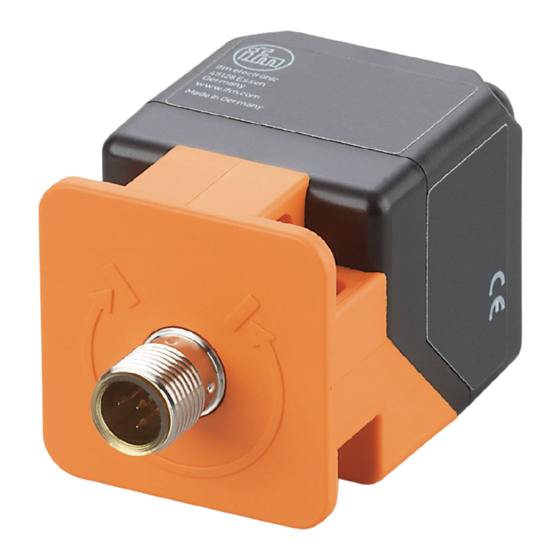Table of Contents
Advertisement
Quick Links
Advertisement
Table of Contents

Subscribe to Our Youtube Channel
Summary of Contents for IFM ANT513
- Page 1 Operating instructions RF-identification system ANT513 Read/write head...
-
Page 2: Table Of Contents
ANT513 Contents Preliminary note ............. -
Page 3: Preliminary Note
Warning of damage to property 1.3 Legal and copyright information © All rights reserved by ifm electronic gmbh. No part of these instructions may be reproduced and used without the consent of ifm electronic gmbh. All product names, pictures, companies or other brands used on our pages are the property of the... -
Page 4: Safety Instructions
ANT513 2 Safety instructions General • The unit described is a subcomponent for integration into a system. – The system architect is responsible for the safety of the system. – The system architect undertakes to perform a risk assessment and to create documentation in accordance with legal and normative requirements to be provided to the operator and user of the system. -
Page 5: Intended Use
ANT513 3 Intended use The read/write head reads and writes ID tags without contact. For use, the read/write head must be connected to the DTE10x evaluation unit. The data is converted into digitally coded values and provided to the evaluation unit. -
Page 6: Items Supplied
ANT513 4 Items supplied • Read/write head • 2x hexagonal nut The device is supplied without installation and connection accessories. Available accessories: www.ifm.com. The optimum function is not ensured when using components from other manufacturers. -
Page 7: Function
ANT513 5 Function 5.1 ID tags ID tags are passively operated without a battery. The energy required for operation is provided by the read/write head. The energy is provided via an inductive coupling. The integrated antenna coil in the read/write head generates a magnetic field which partly penetrates the antenna coil of the ID tag. A voltage is generated by induction that supplies the data carrier with energy. -
Page 8: Installation
ANT513 6 Installation 6.1 Notes on the unit installation When mounting several RFID units adhere to the minimum distances between the systems. Flush mounting of a read/write head in metal reduces the read/write distance. Device performance can be affected if positioned in the immediate vicinity of powerful HF emission sources such as welding transformers or converters. -
Page 9: Alignment Of The Sensing Face
ANT513 Fig. 2: Antenna head separated from the fixing element 1 Sensing face 2 Adjustable antenna head 3 Fixing element 6.4 Alignment of the sensing face u Loosen the screw. u Remove the antenna head from the fixing element and turn it. -
Page 10: Mounting Distances
ANT513 Fig. 3: Non-flush mounting Fig. 4: Flush mounting 6.6 Mounting distances Operating mode Distance side (A) Distance front (B) For reading and writing ≥ 300 mm ≥ 250 mm 6.7 Positioning of the ID tag For installation in or on metal use the ID tags provided for this purpose. - Page 11 ANT513 w The distance “D” is indicated in the data sheet. w All indications apply to static read/write operations. Fig. 5: Position the ID tag...
-
Page 12: Electrical Connection
Connect the unit to a DTE10x evaluation unit via the M12 connector. w Voltage is supplied via the evaluation unit. Pin assignment Wiring DATA Information on available sockets see: www.ifm.com. Cables with the following characteristics are suitable for the connection: Length Ohmic resistance (feed + return line) Effective cable capacity <... -
Page 13: Operating And Display Elements
ANT513 8 Operating and display elements Fig. 6: Light indicators 1 LED green: Operating voltage 2 LED yellow: ID tag State Description green operating voltage OK operating voltage missing flashing slowly deactivated yellow on (permanently) ID tag detected on (pulse) ID tag read/written successfully... -
Page 14: Maintenance, Repair And Disposal
9 Maintenance, repair and disposal The unit is maintenance-free. u Contact ifm in case of malfunction. u Do not open the housing as the unit does not contain any components which can be maintained by the user. The unit must only be repaired by the manufacturer. -
Page 15: Approvals/Standards
ANT513 10 Approvals/standards For approvals and standards, the following information is available: • Test standards and regulations: documentation.ifm.com • EU declaration of conformity and approvals: documentation.ifm.com • Notes relevant for approval: package inserts of the device... -
Page 16: Glossary
ANT513 Glossary ID tag An ID tag is used to identify objects. A read/ write device is used to read the ID tag via a high-frequency radio signal. An ID tag consists of an antenna, an analogue circuit for receiving and transmitting (transceiver),...















Need help?
Do you have a question about the ANT513 and is the answer not in the manual?
Questions and answers